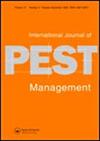小菜蛾(鳞翅目:小菜蛾科)在五种十字花科寄主中的发育和繁殖潜力
IF 1.1
4区 农林科学
Q3 ENTOMOLOGY
引用次数: 0
摘要
摘要小菜蛾(Plutella xylostella(L.))是十字花科作物的主要害虫之一,但关于其在替代寄主上的生物学信息很少,这对其大规模饲养至关重要。研究了不同Brassicaceae对小菜蛾的发育、生物学和种群参数的影响。在实验室条件下,对小菜蛾进行了从幼虫1到成虫的饲养。用甘蓝型油菜(B.napus)、脊状芸苔(Brassica carinata)(埃塞俄比亚油菜)、头状甘蓝(Brassia oleracea var.capitata)(卷心菜)、芜菁(Rapistrom rugosum)和萝卜(Raphanus raphanistrum)喂养幼虫。马齿苋未成熟期发育时间较长(19.19 ± 0.43d),短于萝卜(15.44 ± 0.37d)。在R.rugosum中,达到成年阶段的个体的最高存活率。记录的产卵量最高的是鲁格苏(300.82) ± 24),而萝卜的孵化率最高(79.7%)。小菜蛾在五个宿主中的任何一个宿主中完成其整个周期,是鲁格苏姆最适合高效大规模饲养系统的宿主。本文章由计算机程序翻译,如有差异,请以英文原文为准。
Development and reproductive potential of Plutella xylostella (Lepidoptera: Plutellidae) in five Brassicaceae hosts
Abstract Plutella xylostella (L.) is one of the main pests in Brassicaceae crops, although, information regarding its biology on alternative hosts is scarce, crucial for its mass rearing. We studied the development, biology, and population parameters of P. xylostella, fed with different Brassicaceae. In laboratory conditions, P. xylostella was reared from larva 1 to adult. Larvae were fed with B. napus (rapeseed), Brassica carinata (Ethiopian rape), Brassica oleracea var. capitata (cabbage), Rapistrum rugosum (turnipweed) and Raphanus raphanistrum (radish). The development time of immature stages was longer in B. oleracea var. capitata (19.19 ± 0.43d) and shorter in R. raphanistrum (15.44 ± 0.37d). In R. rugosum, the highest survival of individuals that reached adult stage was achieved. The highest value of oviposited eggs was recorded in R. rugosum (300.82 ± 24), and highest hatching percentage in R. raphanistrum (79.7%). The highest values of net reproductive rate, intrinsic rate of increase and finite rate of growth, were obtained with R. rugosum. P. xylostella complete their whole cycle in any of the five hosts, being R. rugosum most suitable host for an efficient mass rearing system.
求助全文
通过发布文献求助,成功后即可免费获取论文全文。
去求助
来源期刊
CiteScore
4.70
自引率
6.70%
发文量
74
审稿时长
>12 weeks
期刊介绍:
International Journal of Pest Management publishes original research papers and reviews concerned with pest management in the broad sense, covering the control of pests (invertebrates, vertebrates and weeds) and diseases of plants, fungi and their products – including biological control, varietal and cultural control, chemical controland interference methods.
The management of invasive species is of special interest. We also encourage submissions dealing with interactions of multiple pests such as arthropods and plant pathogens, pathogens and weeds or weeds and arthropods as well as those dealing with the indirect and direct effects of climate change on sustainable agricultural practices.

 求助内容:
求助内容: 应助结果提醒方式:
应助结果提醒方式:


